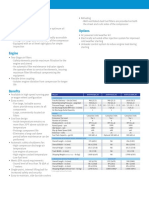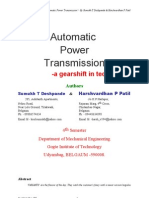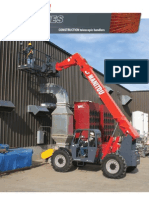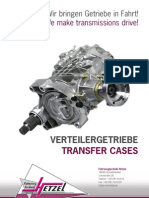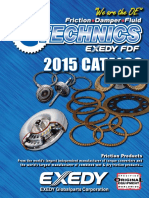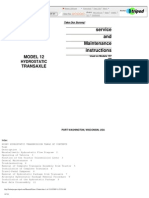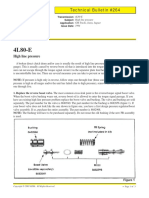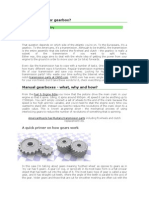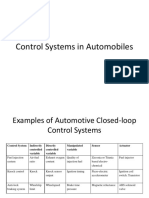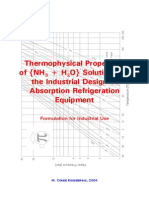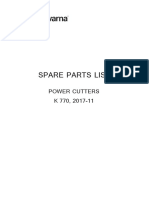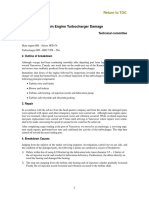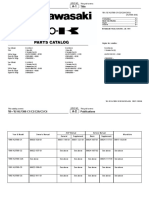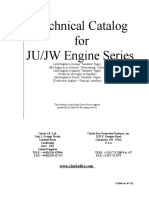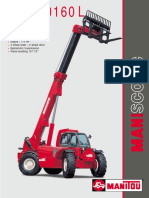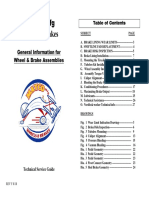The Car Transmission Bible
The Car Transmission Bible
Uploaded by
zeeshanahmad111Copyright:
Available Formats
The Car Transmission Bible
The Car Transmission Bible
Uploaded by
zeeshanahmad111Original Title
Copyright
Available Formats
Share this document
Did you find this document useful?
Is this content inappropriate?
Copyright:
Available Formats
The Car Transmission Bible
The Car Transmission Bible
Uploaded by
zeeshanahmad111Copyright:
Available Formats
The car Transmission Bible - how transmissions and gearbox work including manuals, automatics, clutch, CVT, crash
gearboxes, differentials, limited-slip differentials, 2wd, 4wd, awd and much more.
The Car Bibles Win free stuffWhat's New?Buy eBook / Pics Donate!Contact & feedback CopyrightThe Bike BitRants & Raves Search
The Transmission Bible
I am a pro-car, pro-motorbike petrolhead into basic maintenance. This site is self-published to spread my knowledge. By reading these pages, you agree to indemnify, defend and hold harmless the author, any sponsors and/or site providers against any and all claims, damages, costs or other expenses that arise directly or indirectly from you fiddling with your vehicle as a result of what you read here. If you hurt your vehicle or yourself, don't blame me. Translated versions of this site: Svenska
Page Navigation
Gear/transmission basics & manual gearboxes Sequential & automatic transmissions transmissions & driveline types DSG & CVT
Transmission, or gearbox?
Latest blog entry
10/15/2012 07:00 AM
Remember that time you had trouble getting petrol? Sorry about that.
If you're a reader in the UK, you'll likely have no problem remembering the fuel protests back in 2000. Did you know I was the instigator of what ballooned into a national crisis? A crisis that had fuel drivers blockading their own refineries? That had airports shut down because they had no fuel for the aircraft? That caused Blair to finally admit he was propping up the National Health Service with money fleeced from motorists? The crisis that, for the first and only time in the recent memory of UK fuel pricing, caused the government to drop the tax rate? Yeah you can blame me for that. Late spring 2000, a colleague of mine and I were moaning one morning about the price of petrol at the time and we decided that apathy had ruled long enough and that it was time to do something about it. We set up a website called Boycott The Pumps and filled it with interesting facts and figures. At the time I was running the Speedtrap Bible - a site I later sold - so I had rather a large following of readers. One simple email to all those readers was all it took. We decided to organise a pump boycott - a mechanism that has notoriously failed to go anywhere every time it was tried before, because of apathy. "But if I don't buy petrol today, I'll just buy it tomorrow, so what's the point?". The point isn't that you're buying petrol on another day, it's that you're sending your elected officials a very clear message. And holy crap this time it actually worked. It went nationwide when the Daily Mail picked up the original email from me, and publicised it on the AP Wire and the front page of their paper on the same day. The Sun, Mirror, Star and Telegraph all then picked it up and it just ballooned from there. I must have given 100 radio and newspaper interviews and I was on TV for what seemed like 3 weeks straight from local news stories to the BBC nationally. What really caught the attention of the public though was when the farmers and truckers started to get vocal - rolling roadblocks on the motorways, blockaded refineries and such. At that point it had a much snappier name - wish we'd thought of this originally, but we didn't - it became Dump The Pumps. I had to distance myself from it at that point because the press were invading every aspect of my life, and my family's life, and the life of a lot of my friends. But by that point it didn't matter - the damage had been done. By September 2000 there were queues at petrol stations all across the country. WW2 jerry cans were the hot item to buy and military surplus stores ran out of them. Shortages were everywhere, the refineries were blockaded, trucks were being turned away in France, aircraft weren't landing. Blair even went on TV and told everyone not to panic, and that was brilliant because then people reallystarted to panic. That was when the army reserve were called out to try to maintain some order and use their fuel trucks to supply forecourts across the country. So what was the point of it all? On the day of the original protest, it worked - petrol retailers all across the country reported much, much less take than normal. I proved that one person can make a difference. Yes the price of petrol has continued to go up ever since, and the drop in fuel duty at the time was only 1p. But put that into perspective : no government before or since has ever lowered fuel duty. It's not the amount that counts. It's that I forced them to do it using a grass-roots campaign. Even today's UK government is extremely wary of what happened in 2000, to the point where I've seen it referred to several times since in a "we don't want that to happen again" sort of way. An album of the various newspaper headlines is here if you're curious. Dump the pumps. The local paper - the Bracknell news - has the story of me giving up the initial protest. Chris - www.carbibles.com
That question depends on which side of the Atlantic you're on. To the Europeans, it's a gearbox. To the Americans, it's a transmission. Although to be truthful, the transmission is the entire assembly that sits behind the flywheel and clutch - the gearbox is really a subset of the transmission if you want to split hairs. Either way, this page aims to dea l with the whole idea of getting the power from your engine to the ground in order to move your car (or bike) forwards.
Recommended link: Butts of Bawtry
Manual gearboxes - what, why and how?
From the Fuel & Engine Bible you know that the pistons drive the main crank in your engine so that it spins. Idling, it spins around 900rpm. At speed it can be anything up to 7,500rpm. You can't si mply connect a set of wheels to the end of the crank because the speed is too high and too variable, and you'd need to stall the engine every time you wanted to stand still. Instead you need to reduce the revolutions of the crank down to a usable value. Th is is known as gearing down - the mechanical process of using interlocking gears to reduce the number of revolutions of something that is spinning. Check out AmericanMuscle for all your aftermarket Mustang parts .
A quick primer on how gears work
In this case I'm talking about gears meaning 'toothed wheel' as oppose to gears as in 'my car has 5 gears'. A gear (or cog, or sprocket) in its most basic form is a flat circular object that has teeth cut into the edge of it. The most basic type of gear is called a spur gear, and it has straight -cut teeth, where the angle of the teeth is parallel to the axis of the gear. Wider gears and those that are cut for smoother meshing are often cut with the teeth at an angle , and these are called helical gears. Because of the angle of cut, helical gear teeth have a much more gradual engagement with each other, and as such they operate a lot more smoothly and quietly than spur gears. Gearboxes for cars and motorbikes almost always use helical gears because of this. A side effect of helical gears is that if the teeth are cut at the correct angle - 45 degrees - a pair of gears can be meshed together perpendicular to each other. This is a useful method of changing the direction of movement or thrust in a mechanical system. Another method would be to use bevel gears.
The number of teeth cut into the edge of a gear determines its scalar relative to other gears in a mechanical system. For example, if you mesh together a 20-tooth gear and a 10-tooth gear, then drive the 20 -tooth gear for one rotation, it will cause the 10 -tooth gear to turn twice. Gear ratios are calculated by divinding the number of teeth on the output gear by the number of teeth on the input gear. So the gear ratio here is output/input, 10/20 = 1/2 = 1:2. Gear ratios are often simplified to represent the number of times the output gear has to turn once. In this example, 1:2 is 0.5:1 - "point five to one ". Meaning the input gear has to spin half a revolution to drive the output gear once. This is known as gearing up .
Gearing down is exactly the same only the input gear is now the one with the least number of teeth. In this case, driving the 10 -tooth gear as the input gear gives us output/input of 20/10 = 2/1 = 2:1 - "two to one ". Meaning the input gear has to spin twice to drive the output gear once.
By meshing many gears together of different sizes, you can create a mechanical system to gear up or gear down the number of rotations very quickly. As a final example , imagine an input gear with 10 teeth, a secondary gear with 20 teeth and a final gear with 30 teeth. From the
input gear to the secondary gear, the ratio is 20/10 = 2:1. From the second gear to the final gear, the ratio is 30/20 = 1.5:1. The total gear ratio for this system is (2 * 1.5):1, or 3:1. ie. to turn the output gear once, the input gear has to turn three times. This also neatly shows how you can do the calculation and miss the middle gear ratios - ultimately you need the ratio of input to output. In this example, the final output is 30 and the original input is 10. 30/10 = 3/1 = 3:1.
Collections of helical gears in a gearbox are what give the gearing down of the speed of the engine crank to the final speed of the output shaft from the gearbox. Th e table below shows some example gear ratios for a 5-speed manual gearbox (in this case a Subaru Impreza). RPM of gearbox output shaft when the engine is at 3000rpm 947 1594 2314 3086 4065
Gear 1st 2nd 3rd 4th 5th
Ratio 3.166:1 1.882:1 1.296:1 0.972:1 0.738:1
Final drive - calculating speed from gearbox ratios . It's important to note that in almost all vehicles there is also a final reduction gear. This is also called a final drive or a rear - or front-axle gear reduction and it's done in the differential with a small pinion gear and a large ring gear (see the section on differentials lower down the page). In the Subaru example above, it is 4.444:1. This is the final reduction from the output shaft of the gearbox to the driveshafts coming out of the differential to the wheels. So using the example above, in 5th ge ar, at 3000rpm, the gearbox output shaft spins at 4065rpm. This goes through a 4.444:1 reduction in the differential to give a wheel driveshaft rotation of 914rpm. For a Subaru, assume a wheel and tyre combo of 205/55R16 giving a circumference of 1.985m or 6.512ft (see The Wheel & Tyre Bible). Each minute, the wheel spins 914 times meaning it moves the car (914 x 6.512ft) = 5951ft along the ground, or 1.127 miles. In an hour, that's (60minutes x 1.127miles) = 67.62. In other words, knowing the gearbox ratios and tyre sizes, you can figure out that at 3000rpm, this car will be doing 67mph in 5th gear.
Making those gears work together to make a gearbox
If you look at the image here you'll see a the internals of a generic gearbox. You can see the helical gears meshing with each other. The lower shaft in this image is called the layshaft - it's the one connected to the clutch - the one driven directly by the engine. The output shaft is the upper shaft in this image. To the uneducated eye, this looks like a mechanical nightmare. Once you get done with this section, you'll be able to look at this image and say with some authority, "Ah yes, that's a 5speed gearbox". So how can you tell? Well look at the output shaft. You can see 5 helical gears and 3 sets of selector forks. At the most basic level, that tells you this is a 5-speed box (note that my example has no reverse gear) But how does it work? It's actually a lot simpler than most people think althou gh after reading the following explanation you might be in need of a brain massage. With the clutch engaged (see the section on clutches below), the layshaft is always turning. All the helical gears on the layshaft are permanently attached to it so they al l turn at the same rate. They mesh with a series of gears on the output shaft that are mounted on sliprings so they actually spin around the output shaft without turning it. Look closely at the selector forks; you'll see they are slipped around a series of collars with teeth on the inside. Those are the dog gears and the teeth are the dog teeth. The dog gears are mounted to the output shaft on a splined section which allows them to slide back and forth. When you move the gear stick, a series of mechanical p ushrod connections move the various selector forks, sliding the dog gears back and forth.
In the image to the left, I've rendered a close -up of the area between third and fourth gear. When the gearstick is moved to select fourth gear, the selector fork s lides backwards. This slides the dog gear backwards on the splined shaft and the dog teeth engage with the teeth on the front of the helical fourth gear. This locks it to the dog gear which itself is locked to the output shaft with the splines. When the cl utch is let out and the engine drives the layhshaft, all the gears turn as before but now the second helical gear is locked to the output shaft and voila - fourth gear.
Grinding gears. In the above example, to engage fourth gear, the dog gear is disengaged from the third helical gear and slides backwards to engage with the fourth helical gear. This is why you need a clutch and it's also the cause of the grinding noise from a gearbox when someone is cocking up their gearchange. The common misconception is that this grinding noise is the teeth of the gears grinding together. It isn't. Rather it's the sound of the teeth on the dog gears skipping across the dog teeth of the helical output gears and not managing to engage properly. This typically happens when t he clutch is let out too soon and the gearbox is attempting to engage at the same time as it's trying to drive. Doesn't work. In older cars, it's the reason you needed to do something called double-clutching. Double-clutching, or double-de-clutching (I've heard it called both) was a process that needed to happen on older gearboxes to avoid grinding the gears. First, you'd press the clutch to take the pressure off the dog teeth and allow the gear selector forks and dog gears to slide into neutral, away from the engaged helical gear. With the clutch pedal released, you'd 'blip' the engine to bring the revs up to the speed needed to engage the next gear, clutch-in and move the gear stick to slide the selector forks and dog gear to engage with the next helical g ear.
The synchromesh - why you don't need to double-clutch.
Synchros, synchro gears and synchromeshes - they're all basically the same thing. A synchro is a device that allows the dog gear to come to a speed matching the helical gear before the dog teeth attempt to engage. In this way, you don't need to 'blip' the throttle and double -clutch to change gears because the synchro does the job of matching the speeds of the various gearbox components for you. To the left is a colour -coded cutaway part of my example gearbox. The green cone -shaped area is the syncho collar. It's attached to the red dog gear and slides with it. As it approaches the helical gear, i t makes friction contact with the conical hole. The more contact it makes, the more the speed of the output shaft and free-spinning helical gear are equalised before the teeth engage. If the car is moving, the output shaft is always turning (because ultima tely it is connected to the wheels). The layshaft is usually connected to the engine, but it is free -spinning once the clutch has been operated. Because the gears are meshed all the time, the synchro brings the layshaft to the right speed for the dog gear to mesh. This means that the layshaft is now spinning at a different speed to the engine, but that's OK because the clutch gently equalises the speed of the engine and the layshaft, either bringing the engine to the same speed as the layshaft or vice versa depending on engine torque and vehicle speed.
So to sum up that very long -winded description, I've rendered up an animation - when you see parts of a gearbox moving in an animation, it'll make more sense to you. What we have here is a single gear being engaged. The layshaft the blue shaft with the sma ller helical gear attached to it. To start with, the larger helical gear is free -spinning on its slip ring around the red output shaft - which is turning at a different speed because it's connected to the wheels. As the gear stick is moved, the gold selector collar begins to slide the dog gear along the splines on the output shaft. As the synchromesh begins to engage with the large helical gear, the helical gear starts to spin up to speed to match the output shaft. Because it is meshed with the gear on the layshaft, it in tur n starts to bring the layshaft up to speed too. Once the speed of everything is matched, the dog gear locks in place with the output helical gear and the clutch can be engaged to connect the engine to the wheels again.
o o
00:00 / 00:00
o o o o o o o o o
What about reverse?
Reverse gear is normally an extension of everything you've learned above but with one extra gear involved. Typically, there will be three gears that mesh together at one point in the gearbox instead of the customary two. There will be a gear each on the la yshaft and output shaft, but there will be a small gear in between them called the idler gear. The inclusion of this extra mini gear causes the last helical gear on the output shaft to spin in the opposite direction to all the others. The principle of enga ging reverse is the same as for any other gear - a dog gear is slid into place with a selector fork. Because the reverse gear is spinning in the opposite direction, when you let the clutch out, the gearbox output shaft spins the other way - in reverse. Simple. The image on the left here shows the same gearbox as above modified to have a reverse gear.
Crash gearboxes or dog boxes.
Having gone through all of that business about synchromeshes, it's worth mentioning what goes on in racing gearboxes. These are also known as crash boxes, or dog boxes, and use straight -cut gears instead of helical gears. Straight-cut gears have less surface area where the gears contact each other, which means less friction, which means less loss of power. That's why people who make racing boxes like to use them. Normally, straight-cut gears are mostly submerged in oil rather than relying on it sloshing around like it does in a normal gearbox. So the extra noise that is generated is reduced to a (pleasing?) whine by the sound-deadening effects of the oil.
But what is a dog box? Well - motorbikes have been using them since the dawn of time. Beefing the system up for cars was the brainchild of a racing mechanic who wanted to provide teams with a quick method of altering gear ratios in the pits without having to play "chase the syncro hub ball bearings" as they fell out on to the garage floor.
Normal synchro gearboxes run at full engine speed as the clutch directly connects the input shaft to the engine crank. Dog boxes run at a half to a third the speed of the engine because there is a step -down gear before the gearbox. The dog gears in a dog box also have less teeth on them than those in a synchro box and the teeth are spaced further apart. So rather than having an exact dog -tooth to dog-hole match, the dog teeth can have as much as 60 "free space" between them. This means that instead of needing an exact 1 -to-1 match to get them to engage, you have up to 1/6th of a rotation to get the dog teeth pressed together before they touch eac h other and engage. The picture on the right shows the difference between synchro dog gears and crash box dog gears. So the combination of less, but larger dog teeth spaced further apart, and a slower spinning gearbox, allegedly make for an easier -to-engage crash box. In reality, it's still quite difficult to engage a crash box because you need exactly the right rpm for each gear or you'll just end up grinding the dog teeth together or having them bounce over each other. That results in metal filings in your transmission fluid, which ultimately results in an expensive and untimely gearbox rebuild. But it is more mechanically reliable - it's stronger and able to deal with a lot more power and torque which is why it's used in racing. So in essence, a dog box relies entirely on the driver to get the gearchange right. Well - sort of. Nowadays the gearboxes have ignition interrupters connected to them. As you go to change gear, the ignition system in the engine is cut for a fraction of a second as you come to the point where the dog teeth are about to engage. This momentarily removes all the drive input from the gearbox making it a hell of a lot easier to engage the gears. And when I say 'momentary' I mean milliseconds. Because of this, it is entirely possible to upshift and downshift without using the clutch (except from a standstill). Pull the gear out of first, and as you blip the throttle to get the engine to about the right speed, the ignition is cut just as the gears engage. Even the blip of the throttle isn't necessary now either - advanced dog boxes can also attempt to modify the engine speed by adjusting the throttle input to get the revs to the right range first. Of course even with all this cleverness, you still get nasty mechanic al wear from cocked up gear changes, but in racing that doesn't matter - the gearbox is stripped down and rebuilt after each race.
Before the gearbox - the clutch
So now you have a basic idea of how gearing works there's a second item in your transmission that you need to understand - the clutch. The clutch is what enables you to change gears, and sit at traffic lights without stopping the engine. You need a clutch because your engine is running all the time which means the crank is spinning all the time. Y ou need someway to disconnect this constantly -spinning crank from the gearbox, both to allow you to stand still as well as to allow you to change gears. The clutch is composed of three basic elements; the flywheel, the pressure plate and the clutch plate(s ). The flywheel is attached to the end of the main crank and the clutch plates are attached to the gearbox layshaft using a spline. You'll need to look at my diagrams to understand the next bit because there are some other items involved in the basic operation of a clutch. (I've rendered the clutch cover in cutaway in the first image so you can the inner components.) So here we go.
In the diagram here, the clutch cover is bolted to the flywheel so it turns with the flywheel. The diaphragm springs are conn ected to the inside of the clutch cover with a bolt/pivot arrangement that allows them to pivot about the attachment bolt. The ends of the diaphragm springs are hooked under the lip of the pressure plate. So as the engine turns, the flywheel, clutch cover, diaphragm springs and pressure plate are all spinning together. The clutch pedal is connected either mechanically or hydraulically to a fork mechanism which loops around the throw -out bearing. When you press on the clutch, the fork pushes on the throw -out bearing and it slides along the layshaft putting pressure on the innermost edges of the diaphragm springs. These in turn pivot on their pivot points against the inside of the clutch cover, pulling the pressure plate away from the back of the clutch plates . This release of pressure allows the clutch plates to disengage from the flywheel. The flywheel keeps spinning on the end of the engine crank but it no longer drives the gearbox because the clutch plates aren't pressed up against it. As you start to release the clutch pedal, pressure is released on the throw-out bearing and the diaphragm springs begin to push the pressure plate back against the back of the clutch plates, in turn pushing them against the flywheel again. Springs inside the clutch plate absor b the initial shock of the clutch touching the flywheel and as you take your foot off the clutch pedal completely, the clutch is firmly pressed against it. The friction material on the clutch plate is what grips the back of the flywheel and causes the input shaft of the gearbox to spin at the same speed. Burning your clutch You might have heard people using the term 'burning your clutch'. This is when you hold the clutch pedal in a position such that the clutch plate is not totally engaged against the back of the flywheel. At this point, the flywheel is spinning and brushing pas t the friction material which heats it up in much the same was as brake pads heat up when pressed against a spinning brake rotor (see the Brake Bible). Do this for long enough and you'll smell it because you're burning off the friction material. This can also happen unintentionally if you rest your foot on the clutch pedal in the course of normal driving. That slight pressure can be just enough to release the diaphragm spring enough for the clutch to occasionally lose grip and burn. A slipping clutch The other term you might have heard is a 'slipping clutch'. This is a clutch that has a mechanical problem. Either the diaphragm spring has weakened and can't apply enough pressure, or more likely the fri ction material is wearing down on the clutch plates. In either case, the clutch is not properly engaging against the flywheel and under heavy load, like accelerating in a high gear or up a hill, the clutch will disengage slightly and spin at a different ra te to the flywheel. You'll feel this as a loss of power, or you'll see it as the revs in the engine go up but you don't accelerate. Do this for long enough and you'll end up with the above - a burned out clutch.
Like the site? The page you're reading is free, but if you like what you see and feel you've l something, a small donation to help pay down my car loan would be appreciated. Thank y
Motorcycle 'basket' clutches
It's worth spending a moment here to talk about basket clutches as found on some Yamaha motorbikes. Even though the basic principle is the same (sandwiching friction-bearing clutch plates against a flywheel), the design is totally different. If nothing els e, a quick description of basket clutches will show you that there's more than one way to decouple the a spinning crank from a gearbox. Basket clutches need to be compact to fit in a motorbike frame so they can't have a lot of depth to them. They also need to be readily accessible for mechanics to be able to service them with the minimum amount of fuss, something that's near impossible with regular car clutches. A basket clutch has a splined clutch boss bolted to the shaft coming from the engine crank with strong springs. Metal pressure plates slide on to this shaft, in alternating sequence with friction material clutch plates. The clutch plates are splined around the outside edge, where they fit into slots in an outer basket - the clutch housing. The clutch housing is bolted on to the layshaft which runs back through the middle of the whole mechanism and into gearbox. Clever, but as usual, not much use without a picture, so here you go.
In operation, a basket clutch is simplicity itself. A throw -out bearing slides around the outside of the layshaft and when you pull the clutch lever, the throw-out bearing pushes against the clutch boss. The clutch boss compresses the clutch springs and removes pressure from the whole assembly. The friction plates now spin freely in between the pressure plates. When you let the clutch out, the springs push the clutch boss in again and it re-asserts the pressure on the system, crushing the fric tion and pressure plates together so they grip. And there you have a second type of clutch. You should now feel proud that with all your newfound (and somewhat geeky) understanding of clutches, you can go about your business safe in the knowledge that you sort of understand how all this spinning, geared and-splined witchcraft works.
Page Navigation
Gear/transmission basics & manual gearboxes Sequential & automatic transmissions transmissions & driveline types
th
DSG & CVT
These pages were last updated on 19 July 2012. Copyright Chris Longhurst 1994 - 2012 unless otherwise noted. Important Copyright info.
Read more: http://www.carbibles.com/transmission_bible.html#ixzz29khzYJ5g
You might also like
- Arctic Cat 2008 Prowler XT XTX Service ManualDocument174 pagesArctic Cat 2008 Prowler XT XTX Service ManualMyBriggs67% (3)
- Yamaha Gp1200 Owners ManualDocument3 pagesYamaha Gp1200 Owners ManualGregoryNo ratings yet
- M32 PDFDocument17 pagesM32 PDFRodrigo ChinelattoNo ratings yet
- Automatic Transmission: DaihatsuDocument95 pagesAutomatic Transmission: Daihatsugroomblack5No ratings yet
- Air Compressors Data Sheet 900 1070cfm T1 2Document1 pageAir Compressors Data Sheet 900 1070cfm T1 2arif rahmanNo ratings yet
- Step Less TransmissionDocument5 pagesStep Less TransmissionAsif ali H.Dhalayat100% (1)
- Air Conditioning Compressor/Clutch Service ManualDocument2 pagesAir Conditioning Compressor/Clutch Service Manualromulofcarrera100% (1)
- Rep S5DDocument151 pagesRep S5DDoru DariusNo ratings yet
- Motor QSB3.3 PDFDocument2 pagesMotor QSB3.3 PDFDiego Paredes100% (1)
- Fjernstart Fyr VolvoDocument22 pagesFjernstart Fyr VolvoTonny PedersenNo ratings yet
- Mercedes 722.5 AutoDocument2 pagesMercedes 722.5 Autocorie132100% (1)
- Acoustics Wave EquationsDocument27 pagesAcoustics Wave Equationszeeshanahmad111No ratings yet
- Case 580sn Super N Tier IV - ADocument1,734 pagesCase 580sn Super N Tier IV - AMichael Kubler100% (3)
- Export Car Sim VariableDocument19 pagesExport Car Sim Variabledanuega1No ratings yet
- Automatic Power TransmissionDocument23 pagesAutomatic Power Transmissionrohit patil100% (6)
- Toyota Camry ATF Fluid Exchange MergedDocument18 pagesToyota Camry ATF Fluid Exchange MergedKhoa NguyenNo ratings yet
- Manitou MT Series (EN-US)Document12 pagesManitou MT Series (EN-US)Manitou100% (2)
- Chapter Electric Fuel Injection SystemDocument92 pagesChapter Electric Fuel Injection Systemcamionetanissanz20No ratings yet
- Hyundai Atos Engine SpecificationsDocument1 pageHyundai Atos Engine SpecificationsnuryahmanNo ratings yet
- SSP-285 Running Gear Audi A8 Part 2 PDFDocument31 pagesSSP-285 Running Gear Audi A8 Part 2 PDFRizwan HameedNo ratings yet
- Dodge Nitro KA - 2007 - ClutchDocument29 pagesDodge Nitro KA - 2007 - ClutcheephantomNo ratings yet
- Range Sensor 1Document2 pagesRange Sensor 1tomahi100% (1)
- Gear Ratio: Navigation Search Gear TrainDocument53 pagesGear Ratio: Navigation Search Gear Trainjai karanNo ratings yet
- Aisin Warner AW4 Automatic Transmission PDFDocument120 pagesAisin Warner AW4 Automatic Transmission PDFRichard Andrianjaka LuckyNo ratings yet
- SWAG Fluessigkeiten 2012 2013Document33 pagesSWAG Fluessigkeiten 2012 2013Hatem Nasr100% (1)
- U6600E Shift ProblemsDocument4 pagesU6600E Shift ProblemsAlex Maceira Graterol100% (1)
- 01J Clutch Clearances: Technical Information BulletinDocument1 page01J Clutch Clearances: Technical Information Bulletinfadrique54No ratings yet
- Capacidade e Especificacoes - h155Document22 pagesCapacidade e Especificacoes - h155leonardo100% (1)
- Transfer CasesDocument172 pagesTransfer CasesRaca Zivkovic100% (1)
- EXEDY Friction Technics Catalog Fall 2014 WebDocument116 pagesEXEDY Friction Technics Catalog Fall 2014 Webali4299100% (1)
- CNC Table Waterjet Cutting MachineDocument9 pagesCNC Table Waterjet Cutting MachinetomychalilNo ratings yet
- Bosch - Dados Bicos InjetoresDocument25 pagesBosch - Dados Bicos InjetoresClaudio GibeiliNo ratings yet
- 4HP20Document140 pages4HP20suattosun100% (2)
- 418 Electrical Distribution PDFDocument181 pages418 Electrical Distribution PDFMaxy ServiçosNo ratings yet
- Suspension Trasera 97-98Document6 pagesSuspension Trasera 97-98kilofome05No ratings yet
- AL4 Pressure Regulation FaultDocument3 pagesAL4 Pressure Regulation FaultJesús PonceNo ratings yet
- 840 TransmisionsDocument19 pages840 TransmisionskaesarNo ratings yet
- 23A Automatic TransaxleDocument81 pages23A Automatic Transaxletakedashinden100% (1)
- Continuously Variable TransmissionDocument52 pagesContinuously Variable TransmissionPrints BindingsNo ratings yet
- Caution / Notice / HintDocument15 pagesCaution / Notice / HintZouhair WahbiNo ratings yet
- th200 4r TDocument6 pagesth200 4r TRainbow WalkerNo ratings yet
- Automatic Transmission: Presented by Shiv Raj Khoja Mechanical Iv YearDocument28 pagesAutomatic Transmission: Presented by Shiv Raj Khoja Mechanical Iv YearShiv Raj Khoja100% (1)
- 1722slid PDFDocument210 pages1722slid PDFJose VidalNo ratings yet
- CIAZDocument20 pagesCIAZFelipe Stang González0% (1)
- 06 GA6HP26Z Auto Trans ColorDocument48 pages06 GA6HP26Z Auto Trans ColorGeorge HristovNo ratings yet
- Transmission NoteDocument6 pagesTransmission Notesyariza ismailNo ratings yet
- Eaton 12 Service ManualDocument12 pagesEaton 12 Service ManualfowljimtNo ratings yet
- GR-150XL: 15 Ton Capacity (13.6 Metric Tons) Hydraulic Rough Terrain CraneDocument12 pagesGR-150XL: 15 Ton Capacity (13.6 Metric Tons) Hydraulic Rough Terrain CraneHo Chee YongNo ratings yet
- Solenoid Res N TestingDocument12 pagesSolenoid Res N TestingFrank Araya DiazNo ratings yet
- Atb264 Isuzu 4l80-E Alta Presion en La Linea (Broken Direct Clutch or Case)Document3 pagesAtb264 Isuzu 4l80-E Alta Presion en La Linea (Broken Direct Clutch or Case)AleNo ratings yet
- AT2011 FordDocument131 pagesAT2011 FordJose Heriberto Torres100% (1)
- ClutchesDocument2 pagesClutchesAlonzo Ribera100% (1)
- Transmission Removal and Installation at PDFDocument4 pagesTransmission Removal and Installation at PDFOskars ŠtālsNo ratings yet
- Attention: 62TE Installation GuideDocument2 pagesAttention: 62TE Installation Guideiriana2009No ratings yet
- Ciaz 2014keyless Start System-01-01Document36 pagesCiaz 2014keyless Start System-01-01jag18718No ratings yet
- Semi Automatic Transmission ReportDocument52 pagesSemi Automatic Transmission ReportPranav EkhandeNo ratings yet
- 0CJ Averia C05ED00 y C05ED Problema Diferencial Trasero Sistema Ultra QuattroDocument17 pages0CJ Averia C05ED00 y C05ED Problema Diferencial Trasero Sistema Ultra QuattroMario Mastronardi100% (1)
- Unit - 1: Automotive FundamentalsDocument26 pagesUnit - 1: Automotive FundamentalsvedhhNo ratings yet
- Thomson Electrac HD Linear Actuator Motion Control per CAN BusFrom EverandThomson Electrac HD Linear Actuator Motion Control per CAN BusNo ratings yet
- Transmission BibleDocument10 pagesTransmission BibleSoham DeNo ratings yet
- How Manual Transmissions Work: Daimlerchrysler Pictures of TransmissionsDocument10 pagesHow Manual Transmissions Work: Daimlerchrysler Pictures of TransmissionsKatu2010No ratings yet
- Car BibleDocument3 pagesCar BibleSoheil YadNo ratings yet
- High and Low Range Gear ConceptDocument11 pagesHigh and Low Range Gear ConceptHimanshu Witwicky100% (1)
- Design of Barrier: A Case StudyDocument15 pagesDesign of Barrier: A Case Studyzeeshanahmad111No ratings yet
- Sound Energy DensityDocument5 pagesSound Energy Densityzeeshanahmad111No ratings yet
- Initial Investment $2,000,000.00 Year Cash Flow 1 $1,000,000 2 $1,000,000 3 $1,000,000Document3 pagesInitial Investment $2,000,000.00 Year Cash Flow 1 $1,000,000 2 $1,000,000 3 $1,000,000zeeshanahmad111No ratings yet
- Practice Problems Based On Free & Forced Vibrations of SDOF SystemDocument3 pagesPractice Problems Based On Free & Forced Vibrations of SDOF Systemzeeshanahmad111No ratings yet
- MufflerElementAnalysis2014 ConciseDocument21 pagesMufflerElementAnalysis2014 Concisezeeshanahmad111No ratings yet
- Dowry System in IndiaDocument4 pagesDowry System in Indiazeeshanahmad111No ratings yet
- INCONTROL Simulation Solutions ED9 S ENGDocument2 pagesINCONTROL Simulation Solutions ED9 S ENGzeeshanahmad111No ratings yet
- Lighting FundamentalsDocument43 pagesLighting Fundamentalszeeshanahmad111No ratings yet
- List of Online Journals SDocument8 pagesList of Online Journals Szeeshanahmad111No ratings yet
- Time Table For ExamDocument5 pagesTime Table For Examzeeshanahmad111No ratings yet
- Solutions Stoeker JonesDocument14 pagesSolutions Stoeker Joneszeeshanahmad111No ratings yet
- Caste System in IndiaDocument13 pagesCaste System in Indiazeeshanahmad1110% (1)
- Library Book ListDocument24 pagesLibrary Book Listzeeshanahmad111No ratings yet
- Stacking Sequence Optimization With Genetic Algorithm Using A Two-Level ApproximationDocument11 pagesStacking Sequence Optimization With Genetic Algorithm Using A Two-Level Approximationzeeshanahmad111No ratings yet
- Particle Moving On A Circle: The Two-Dimensional Rotor: CYL110/ChakravartyDocument8 pagesParticle Moving On A Circle: The Two-Dimensional Rotor: CYL110/Chakravartyzeeshanahmad111No ratings yet
- Indian Economy On The Eve of IndependenceDocument37 pagesIndian Economy On The Eve of Independencezeeshanahmad11167% (3)
- Propagation of Highly Nonlinear Solitary Waves in A Curved Granular ChainDocument10 pagesPropagation of Highly Nonlinear Solitary Waves in A Curved Granular Chainzeeshanahmad111No ratings yet
- Traction Control SystemDocument4 pagesTraction Control Systemzeeshanahmad111100% (1)
- Control Systems in Automobile PDFDocument36 pagesControl Systems in Automobile PDFVinoth MalaikaniNo ratings yet
- Aqua Ammonia PropertiesDocument0 pagesAqua Ammonia Propertieszeeshanahmad111No ratings yet
- Free Convection: Its Free, No Operating Cost! .. Its Natural .Document34 pagesFree Convection: Its Free, No Operating Cost! .. Its Natural .zeeshanahmad111No ratings yet
- Boundary Layer NotesDocument17 pagesBoundary Layer NotesgarystevensozNo ratings yet
- 001-047 Piston Rings: Failure Analysis InspectionDocument8 pages001-047 Piston Rings: Failure Analysis InspectionWaad HarbNo ratings yet
- Husqvarna K770 Demo Saw IPLDocument35 pagesHusqvarna K770 Demo Saw IPLampacpartsNo ratings yet
- Main Engine Turbocharger Damage: 1. ModelDocument2 pagesMain Engine Turbocharger Damage: 1. ModelRani NoumanNo ratings yet
- Cylinder Leak-Down Testing: The TestDocument2 pagesCylinder Leak-Down Testing: The TestZamriNo ratings yet
- klf300 c1c4 4wd Parts List PDFDocument108 pagesklf300 c1c4 4wd Parts List PDFOliverNo ratings yet
- Supplementary: For Xs650Se Models After Engine Serial Number 2fo-114241Document25 pagesSupplementary: For Xs650Se Models After Engine Serial Number 2fo-114241OliverNo ratings yet
- Common Rail Crs3 Con 2000 A 2500 Bard y PiezoelectricoDocument2 pagesCommon Rail Crs3 Con 2000 A 2500 Bard y PiezoelectricoBer HonzaNo ratings yet
- Mazda Fe y f2Document27 pagesMazda Fe y f2Nicolás CastroNo ratings yet
- Section K: Service Manual - JS200, JS140 & JS205Document6 pagesSection K: Service Manual - JS200, JS140 & JS205Naing Min HtunNo ratings yet
- VX WH VU GEN3 Series2 5e WiringDocument2 pagesVX WH VU GEN3 Series2 5e WiringDanniel PizattoNo ratings yet
- 2018 Arctic Cat ZR200 Service ManualDocument70 pages2018 Arctic Cat ZR200 Service ManualTim MckennaNo ratings yet
- Beijing Jincheng Mining Technology Co., LTD: No. Description Model Q'Ty Unit Unit Price Amount Fob Beijing UsdDocument2 pagesBeijing Jincheng Mining Technology Co., LTD: No. Description Model Q'Ty Unit Unit Price Amount Fob Beijing UsdDenNo ratings yet
- Kioti Daedong DK450L Tractor Service Repair Manual PDFDocument17 pagesKioti Daedong DK450L Tractor Service Repair Manual PDFfujsjefkksemNo ratings yet
- Dynacargo Gomas CatalogoDocument12 pagesDynacargo Gomas Catalogoabel jacoboNo ratings yet
- Spare Parts List: Tamping RollerDocument645 pagesSpare Parts List: Tamping RollerBruno RibeiroNo ratings yet
- Technical Catalog JD c13965 PDFDocument473 pagesTechnical Catalog JD c13965 PDFOmar BecerraNo ratings yet
- Turbo: MHT 10160 LDocument4 pagesTurbo: MHT 10160 Ldaut100% (1)
- Rms Form 45071423 Motorcycle Pre Delivery ChecklistDocument2 pagesRms Form 45071423 Motorcycle Pre Delivery ChecklistAnderson DuarteNo ratings yet
- 4jh5e Parts ManualDocument54 pages4jh5e Parts ManualKALILNo ratings yet
- Caterpillar G3306B NA Hoja de Datos PDFDocument4 pagesCaterpillar G3306B NA Hoja de Datos PDFJUAN CARLOS velazquez hernandezNo ratings yet
- Parts bookCASE 580SN PDFDocument539 pagesParts bookCASE 580SN PDFHuda Huda100% (2)
- Technical Data: Program For GermanyDocument2 pagesTechnical Data: Program For GermanykillerpollisNo ratings yet
- Project Report: - Suspension SystemDocument33 pagesProject Report: - Suspension SystemAnil KumarNo ratings yet
- COZDocument3 pagesCOZChaminda MotorsNo ratings yet
- DiagramDocument3 pagesDiagramRajan MullappillyNo ratings yet
- Wheels & BrakesDocument14 pagesWheels & BrakesJoshua Saldana VélezNo ratings yet
- Nissan Błędy PDFDocument358 pagesNissan Błędy PDFUrszula Walczewska100% (1)




